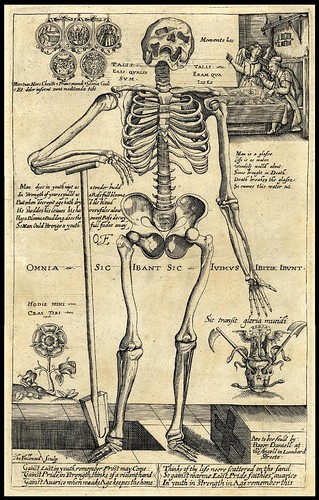
Untitled, 1620s
Published by Roger Daniell
Print made by Thomas Fullwood
Description: A skeleton leaning on a spade by an open grave; top left, numbered medallions with explanations of the scenes inscribed below, '1 Mors tua 2 Mors Christi 3 Fraus mundi 4 Gloria Coeli 5 Et dolor inferni sunt meditanda tibi'; top right, a man with scales counting his money, while an angel points to the skeleton, with the accompanying inscription 'Memento hoc'; in the centre, verses on life and death, and the motto 'Omnia sic ibant sic ivimus ibitis, ibunt'; bottom left, flowers on a grave, with the inscription 'Hodie mihi cras tibi'; bottom right, a death's head, with the inscription 'Sic transit gloria mundi'. 1620/1629 Engraving
Inscription: In addition to inscriptions explaining the various scenes, lettered with six lines of verse in the lower margin, and production details: 'Tho: Fullwood sculp:' and 'Are to bee sould by Roger Daniell at the Angell in Lumbard Streete:'
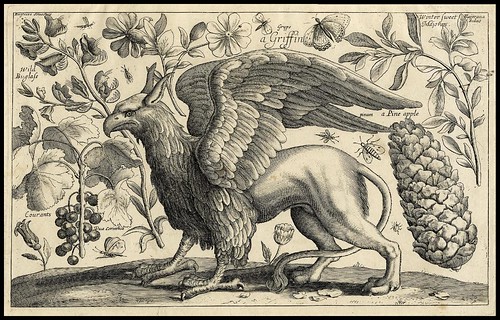
Title: Animalium, ferarum et bestiarum, 1663
One of a series of plates entitled Animalium, ferarum et bestiarum, issued by Stent and Hollar, with various engravers.
Description: A griffin, surrounded by numerous plants, flowers, and insects, and a pineapple.
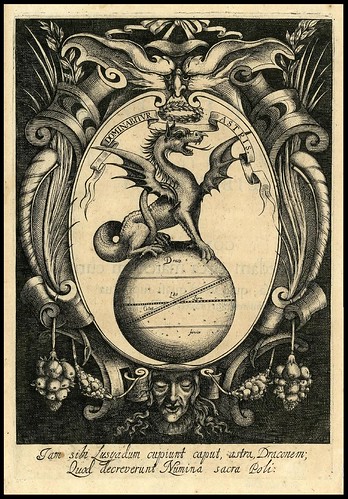
Title: Iam sibi Lusyadum cupiunt caput, astra, Draconem; Quod decreverunt Numina sacra Poli, 1645
Print made by John Droeshout
Description: A dragon on top of a globe within an oval cartouche; wreath and banderole with motto 'Dominabitur astris' above dragon, and inscriptions identifying stars and constellations on the globe; two heads, palm branches and bunches of fruit adorning the cartouche; illustration to page 708 of Antonio de Sousa de Macedo, 'Lusitania Liberata ab injusto Castellanorum dominio' (London, Richard Heron, 1645).
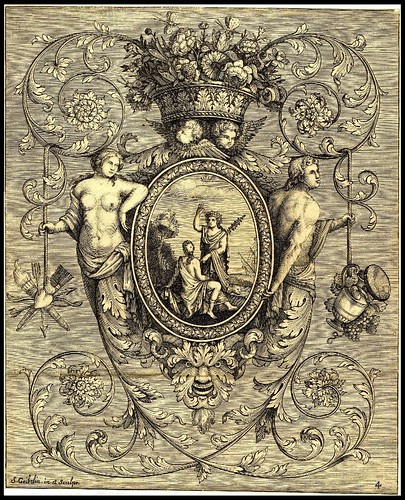
Title: A Book of Seuerall Ornaments inuented & ingraued by Sgribelin, 1682
Print made by Simon Gribelin
Description: Bacchus and Ariadne in an oval flanked by two terms; plate 4 from a set of ornament prints.
Comments by Antony Griffiths IN: 'The Print In Stuart Britain' (1998) - "This set of ornament prints is the earliest known work by Gribelin. It contains a titleplate and six other plates, which show small mythological scenes set into surrounds with putti and elaborate scrolls. The title is given both in French and English. In the context of French printmaking, they are of no particular interest, for the plates are standard exercises in the then fashionable style of Jean Berain.
But in Britain they were something new. Gribelin published one other set of eight ornament prints of different character and smaller size under the title 'A book of ornaments usefull to jewellers, watchmakers and all other artists' in 1697. Two series that he published under new titles in 1700 and 1704 (12 leaves priced at 3 shillings) are simply reworkings of the plates of these two sets. His designs were already old-fashioned then, but they remained in print long after his death. His son advertised them in 'The Evening Post' of 18 March 1736; from him they passed to Mr Pascall, picture frame-maker, at the Golden Head over against Hanover Street in Long Acre (The Daily Post, 21 February 1738), and they later turn up in the stock of John Bowles, who died in 1779."
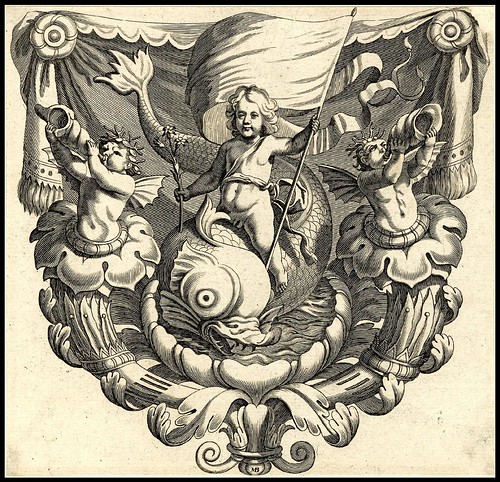
Untitled, about 1680 - 1710
Print made by Michael Burghers
Description: Cupid, nude, riding a monstrous fish, holding a flower in right hand and a flag in left hand; to the sides and below, two horns out of which two winged boys blow on conches; in the background, a curtain.

Title: A Trew Draught of the Whale as he was seen at Blackwall-Dock, 1690
Published by John Drapentier
Description: Whale washed up on the banks of the Thames, with spectators at right, visitors on boats approaching the shore at left, and view of east London in the background.
Inscription: Lettered with title, text below image describing the whale and the incident, and publication line: 'Sold by Iohn Drapentier Ingravor in S.t Martins Legrand.'

Untitled, between 1596 and 1603
Print made by Thomas Cockson
Description: Charles Howard of Effingham, Earl of Nottingham, mounted on a prancing horse, in the background views of the Armada and the English fleet in Cadiz.
Inscription: Lettered with name and titles in top left corner, his arms in top right surrounded by a garter, and in the bottom margin four lines of Latin verse. With address of an unidentified publisher 'To be solde at the horseshew in pater noster row'.

Title: Elizabetha Angliae et Hiberniae Reginae &c, 1625
Print made by Thomas Cecill
Published by Peter Stent
Description: Portrait of Queen Elizabeth seated on horseback cross-saddle, in armour holding a sword, with a naked female labelled 'Treuth' holding out a lance to her; under her feet a dragon and in the background the Armada and the army at Tilbury.
Inscription: Lettered with title in sky along top 'Elizabetha Angliae et Hiberniae Reginae &c', and in lower corners 'sould by Peter Stent' and 'T.Cecill sculp'.

Title: The Roial Progenei of our most sacred King Iames.. 1603
Published by Hans Woutneel and Compton Holland
Print made by Benjamin Wright
Description: Genealogical tree of James I in five rows, with James and Anne at the top and Henry VII and Elizabeth at the bottom; in the corners the arms of England and Scotland, and of Lancaster and York.
Inscription: With title along the top 'The Roial Progenei of our most sacred King Iames [...]' and texts under each oval portrait; along the bottom "Benjamin Wright fecit / John Woutneel excu. 1603". In second state Woutneel's address altered to "Comp. Holland excu Lon. 1619".
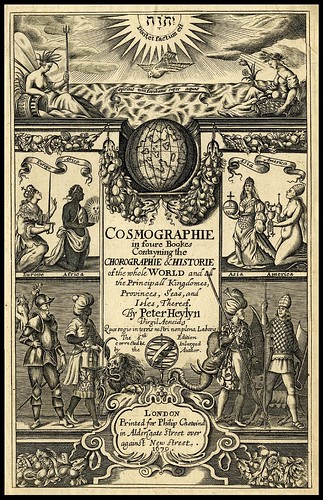
Untitled, 1670
Print made by John Fillian
After Robert Vaughan
Description: Title-page to Peter Heylyn, 'Cosmographie in foure Bookes Contayning the Chorographie & Historie of the whole World and all the Principall Kingdomes, Provinces, Seas, and Isles, Thereof' (London, Philip Chetwind, 1670); title in the centre, beneath a globe and bunches of fruit; either side of the title panels depicting representative male and female figures from Europe, Africa, Asia and America, along with a horse, a lion, an elephant and a wolf; above, the sea, over which the Holy Spirit in the form of a dove is flying, and either side of which are seated two women, one holding a trident, the other a flower; at the top, the sun and the tetragrammaton.
Inscription: Inscribed with full title, captions, scriptural references, and the imprint 'London Printed for Philip Chetwind in Aldersgate street over against New Street. 1670.'
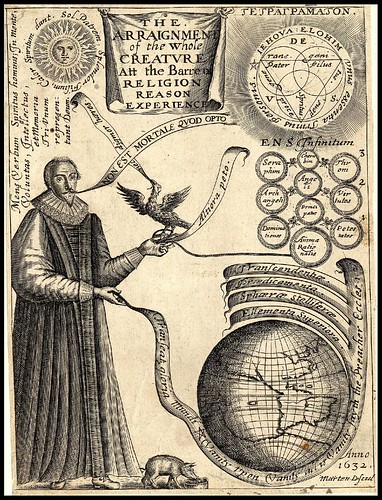
Untitled, 1632
Print made by Martin Droeshout
Description: Frontispiece to Robert Henderson, 'The Arraignment of the Whole Creature Att the Barre of Religion, Reason, Experience'; title on sheet at top centre; on the left, a man (possibly the author) in a gown holds a phoenix in his hand, with a piglet eating from a bowl at his feet; from his mouth, an inscribed scroll, 'Non est mortale quod opto'; from his hand, an inscribed scroll encircling the earth, 'Transeat gloria mundi Vanity upon Vanity all is Vanity sayth the Preacher Eccles. 1.2'; above the globe, several inscribed scrolls; above those, a set of circles illustrating hierarchies in the universe, and above those a set of cirles and a triangle illustrating the Holy Trinity; top left, the sun.
Inscription: Lettered at bottom right 'Anno 1632. Marten. D. scul'

Untitled, 1653
Description: Engraved title-page to Ralph Austen, 'The Spiritual Use of An Orchard or Garden of Fruit Trees' (Oxford, Thomas Robinson); at the top, clasped hands with the inscriptions 'Profits' and 'Pleasures', below which the title; below the title, a formal garden, enclosed by a wall, and encircled by an inscription, 'My garden inclosed is my sister / my Spouse Thy Plants are / an Orchard of Pomegranats with / pleasant fruits Cant 4: 12. 13'; at the four corners of the image, various gardening implements.
Inscription: Lettered with title, inscriptions, and at bottom 'Oxford printed for Tho Robinson 1653' and 'I: Goddard sculp'.
Comments: This impression differs from that listed in Hind in respect of the title of the book. Most copies have the title 'A Treatise of Fruit Trees'; 'The Spiritual Use of An Orchard' appears to be a separate work that was usually printed after the 'Treatise'. This impression appears, therefore, to apply to this separate work, rather than to the 'Treatise'.

Title: Dorothea, Comitissa de Sunderland; The Countesses, 1660 to 1663
Print made (and published) by Pierre Lombart
After: Anthony van Dyck
Description: Portrait of Dorothy, Countess of Sunderland, standing three-quarter length, wearing silk dress with ample sleeves, with right hand resting on monumental stone vase, and left hand pointing up; in ornate frame.
Inscription: Lettered with title and production details: 'Antonius. Van Dyck Eques pinxit', 'P. Lombart sculpsit', and 'londini. auec Pri. du Roy et ex. parisis.'
Comments: Antony Griffiths, IN: 'The Print in Stuart Britain' (London, 1998): "Lombart's most famous work was the series of twelve portraits after van Dyck that he engraved around 1660, often known as the 'Countesses' from the Latin of their titles. Mariette in his entry on Lombart in his Abecedario stated that this set alone would suffice to place him 'au rang des premiers graveurs'. All twelve plates are the same size, and show three-quarter-length figures, ten women and two men, in 15mm wide borders that imitate frames of the period. Walpole described them as 'too well known to be particularised', but the complete list is not easily accessible. It is given here with references to Oliver Millar's catalogue of the paintings of Van Dyck, of 2004.
The women were Anne Carr, Countess of Bedford (IV.22); Lucy, Countess of Carlisle (IV.38); Margaret, Countess of Carlisle (later Manchester) (IV.39); Anna Sophia, Countess of Carnarvon; Elizabeth, Countess of Castlehaven (IV.42); Elizabeth, Countess of Devonshire (IV.90); Rachel, Countess of Middlesex (a title she gained on her re-marriage in 1655) (IV.A4); Penelope, Lady Herbert (IV.A28); Dorothy Sidney, Countess of Sunderland (IV.223); and Elizabeth, Countess of Morton (IV.A24). The two men were Henry Howard, Earl of Arundel (IV.12), and Philip Herbert, Earl of Pembroke (IV.185). Four of the paintings that he copied were in Northumberland House in London, for which they had been commissioned from van Dyck by the 10th Earl of Northumberland (see Jeremy Wood in 'Van Dyck 350', Washington 1994, pp.281-324), of which most are today in Petworth. Presumably the paintings Lombart used for the rest of the set were also available to him in London.
The impression shown here is one of two proofs before letter in the British Museum, the other being of the Countess of Middlesex (1927,1008.374, ex-Masterman Sykes). The issuing of proofs before letter was virtually unheard of in British print publication at this date, although long established on the Continent.
The importing of this practice is a sign of the dignity and standing that Lombart wished to give his series. Another sign is the existence of impressions on a most unusual superfine, almost tissue, paper: examples are to be found in the Bute Granger (eg. IX 47 and 50). It is curious that Lombart never had any link with Lely, and never engraved any of his female portraits made in the tradition of van Dyck.' From cat. 120: 'All but one (the Countess of Devonshire) of the twelve plates of the series combine an English privilege ('Londini avec privileige du Roy') with a note of publication in France by the addition of the words 'et ex. Parisis'.
The positioning of the Paris publication line shows that it was obviously added as an afterthought. This gives the clue for dating the series shortly after the Restoration (the London privilege) and about the same time as Lombart returned to Paris (before 1663). No impressions have ever been recorded of a putative English edition before the addition of 'et ex. Parisis', and the prints must have been simultaneously published in England and France.
Plates of this quality must have taken some years to engrave, and Lombart probably began work in about 1660 or 1661. The series was extremely successful, and remained in print for many years. Hooke noted in his diary for 14 December 1674, 'Bought at Mr Faithorne's Lombards heades 9sh. Paid him 2sh', the rest following on 22 December. On 22 November 1708 Simon Gribelin advertised the set in the London Gazette as 'being one of the best performances in graving, and very proper to adorn rooms, closets etc.' at the price of one guinea. He had presumably used his French connections to purchase the plates from Lombart's heirs in Paris.
Later advertisements for the set appear in the 'London Evening Post' for 17 April 1736, and in the 'Daily Advertiser' for 12 December 1743. Lombart's series was highly influential, and set the pattern for later sets of female beauties. Lely's 'Windsor beauties' showed the Maids of Honour of Catherine of Braganza, and were painted for the Duchess of York before 1668. William III commissioned a set of 'Hampton Court beauties' from Kneller, and these were mezzotinted by the younger Faber (Chaloner Smith 28). Pieter van Gunst engraved a set of ten plates after whole-lengths by van Dyck from the Wharton collection (before they went to Houghton and thence to the Hermitage). These were proposed to subscribers by a syndicate of dealers, Cock, Comyns and McSwiny, who employed Houbraken to come from Holland in 1713 to make the drawings and van Gunst to engrave them in Amsterdam (Walpole III 971, and Vertue III 82).
The set of ten was advertised in the London Gazette on 13 December 1715. Finally, shortly before his death in 1765 James MacArdell had embarked on a set of full-lengths after van Dyck (one of them is Chaloner Smith 168).' See also Simon Turner in Van Dyck and Britain (London, Tate Gallery, 2009), cat. 105. The plates were frequently republished in London. The set was advertised in the 'London Gazette' for 22 November 1708, as being 'very proper to adorn rooms, closets etc.'. They re-appeared in Boydell's catalogue for 1767 at a price of 1 shilling each or 8 s. for the set."

Title: Mrs Anne Killigrew, 1685
Mezzoprint made by Isaac Beckett
After: Anne Killigrew
Published by John Smith
Description: Portrait of Anne Killigrew, head and shoulders in an oval, hair in curls, wearing an earring and low flowered robe. After a self-portrait.
Inscription: Lettered with title followed by 'Painted by her self', and 'I Beckett fec:'
Comments: Probably made in the year of her death as a memorial plate. Russell notes that this is similar, in reverse, to a plate engraved by Blooteling, CS, 1a.
History: Chaloner Smith identifies the following states: I: before inscription II: with inscription III: retouched and published by John Smith.
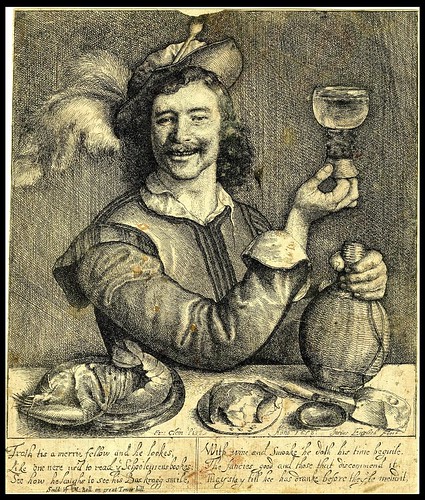
Untitled, 1656
Print made by Josias English
Published by M Bell
After Francis Cleyn
Description: A drinker, seated at a table with a flask and a lobster, holding up a glass of wine. After Francis Cleyn.
Inscription: With etched lettering at bottom of image: 'Fr: Clein: pin:', 'Anno 1656:' and 'Josias English fecit'. With six lines of verse in two columns in margin, and address: 'Sould by M: Bell on great Tower hill'.
Comments: by Antony Griffiths IN: 'The Print in Stuart Britain' (1998) - "This print has often been said to be after a self-portrait by Clein. But it may be doubted that Clein would have painted himself in this way, and the six lines of verse are highly uncomplimentary.
It fits into the tradition of Dutch paintings of boors smoking and drinking, in which artists like Adriaen Brouwer specialised. This is the unique surviving impression of this print, and carries the address 'sould by M.Bell on great Tower Hill'. This publisher is otherwise unknown. The lettering gives every appearance of having been added later, and so this is probably not the first edition."

Untitled, 1666
Print made by Richard Gaywood
After Francis Barlow
Description: Man seated by a table playing a cithern and consulting a score before him, with other musical instruments hanging on the wall; a plate from John Playford's Musicks Delight on the Cithern.
Inscription: With etched lettering 'R Gaywood fecit'.
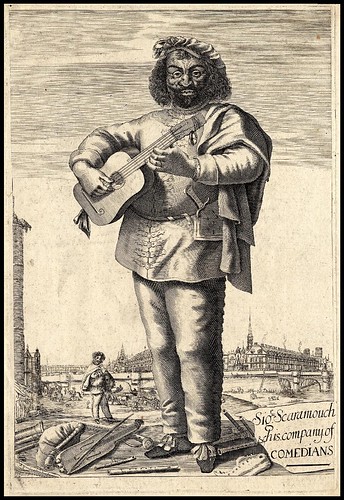
Title: Signor Scaramouch & his company of comedians, about 1670 to 1690
Print made by Jacob Collins
Published by Nicholas Bonnart
Description: A comic actor, dressed in a cap and short coat, playing a small guitar; at his feet, various musical instruments; in the background, a river, bridge and a city scene. [W]
Inscription: Lettered with title and, at bottom left, 'I Collins fecit'.
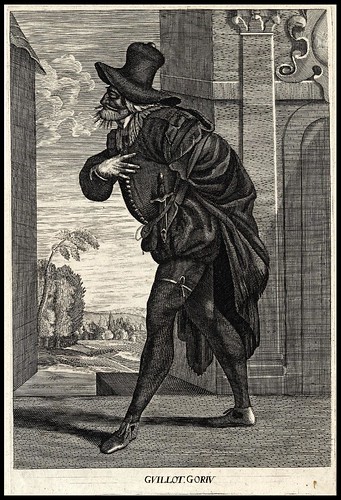
Title: Guillot. Goriv, about 1670 to 1690
Print made by Jacob Collins
Published by Nicholas Bonnart
Description: A comic actor, wearing a large hat and cloak, and a belt with purse and dagger, standing before a building; in the distance, a landscape.
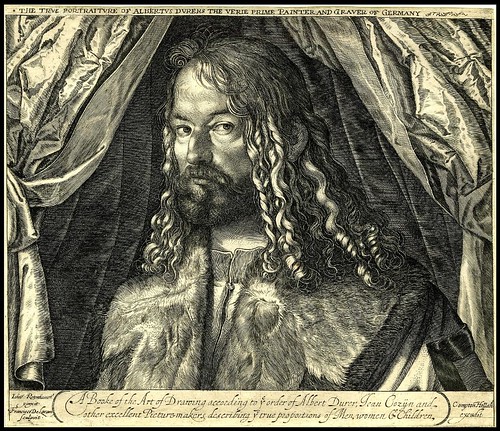
Title: The true portraiture of Albertus Durers the verie prime painter and engraver of Germany, about 1616 to 1620
Print made by Francis Delaram
Published by Compton Holland
After Lucas Kilian
Description: Portrait of Dürer, head and shoulders, after Lucas Kilian; the title-page to A Booke of the Art of Drawing. c.1616/20
Inscription: Lettered with title along the top 'The true portraiture of Albertus Durers the verie prime painter and engraver of Germany', and below the title of the book 'A Booke of the Art of Drawing according to the order of Albert Durer, Jean Cozyn and other excellent picture-makers, describing the true proportions of men, women & children', with the production details 'Iohan Rotenhamer pinxit. Franciscus Delaram sculpsit' and 'Compton Holland excudit'
Comments: See Giulia Bartrum, 'Albrecht Dürer and his Legacy'. This is the only surviving evidence for the earliest English drawing book, which is otherwise only known in later editions by Jenner in 1652 and 1660, and by even later publishers. The portrait derives from the self-portrait in the 'Feast of the Rose Garlands'; the reference to Rottenhamer shows that the plate was copied from Kilian's print, which makes explicit reference to his copy of Dürer's original.
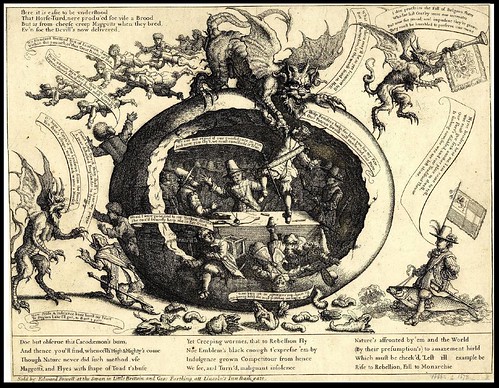
Untitled, about 1673
Print made by Francis Barlow
Published by George Farthing and Edward Powell
Description: Satire against the Dutch; a broken egg of Dutch rebellion reveals Dutchmen plotting round a table, from which they climb to be greeted by devils.
Inscription: With three verses of four lines in lower margin beginning 'Doe but obserue this Cacodæmon's bum ...', and with numerous other captions with text within the design (for which see Stephens); with publication line 'Sold by Edward Powell at the Swan in Little Brittain and Geo: Farthing att Lincoln's Inn Back gate.'

Title: While maskinge in their folleis all doe passe, though all say nay yet all doe ride the asse, 1607
Attributed to Renold Elstrack
Published by John Garrett
Description: Satire on the folly of the world: a group of men attempt to climb on an ass, pulling each other off, watched by a beggar and judge.
Inscription: Lettered with title along the top: 'While maskinge in their folleis all doe passe, though all say nay yet all doe ride the asse'. Four stanzas of verse are given below and more verses beside each character; with a later address 'Printed coloured and sold by John Garrett at the south entrance of the Royall Exchange in Cornhill going up the stayres'.
History: This print was entered in the Stationers' Register on 7 March 1607 by the printer Henry Robertes under the description 'A picture of the Ridinge of the Asse'. Later impressions were published by John Garrett in the late seventeenth century.
Comments: from Antony Griffiths IN: 'The Print in Stuart Britain' (1998) - Although this impression bears the address of the late seventeenth-century publisher John Garrett, Hind recognised that the plate was much earlier, and dated it on the grounds of costume c.1600/10. This can now be confirmed by the discovery of its entry in the Stationers' Register on 7 March 1607 by the printer Henry Robertes under the description 'A picture of the Ridinge of the Asse'.
The text on and under the design, which is completely transcribed by Hind, makes it clear that the print is a general satire on human folly, and does not give it any specific contemporary application. The couplets by each figure are spoken by them, while the ass is left to speak in the four verses below. Dame Punke, Don Pandar, Don Gull the Gallant, Clown and Fool all try to mount the ass, while the beggar leading the ass invites the Judge to mount it, an offer which the Judge wisely declines. The ass complains at its burden, 'The world beneath such weight doth almost crack', and later 'But when you All will ride and each be first, Beware the Asses back you doe not burst'.
John Garrett (active 1674-d.1718/20) was brother-in-law to John Overton, and bought Jenner's business at the Royal Exchange after Jenner's death in 1673. This print is listed in Jenner's catalogue for 1662 as 'The Ridinge of the Asse'. Since Jenner only set up in business c.1618, he cannot have been the first publisher. This could have been Henry Roberts, but he is unknown otherwise as a print publisher. STC records him as a publisher between the 1570s and 1616, but only lists four titles, mostly broadsides. Roberts could simply have been entering the print on behalf of someone else. This is the best designed and best engraved of the satires made in the reign of James. Although Hind catalogued it as anonymous, it is likely to be by Renold Elstrack, who had by far the greatest flair for design of the early engravers.
By the time that Garrett reprinted this impression more than half a century later, the plate had been considerably reworked. That only two impressions survive (the second being in the Houghton Library, Harvard) of a print that remained in production for so long is entirely typical of early British printmaking.

Title: The Mapp of Lubberland or the Ile of Lasye, about 1670
Anonymous; possibly after a painting by Pieter Bruegel
Description: The Land of Cockaigne; six figure lie on the grass, their heads towards tree loaded with food; landscape with satiated man eating his way through mountain of pudding at r, man asleep at the door of his house at l; verses below.
[Addit: see Cockaigne at Wikipedia, which has the imaginary map by Suetter from 1730, as well as an image of Bruegel's painting. Thanks Jennifer!]
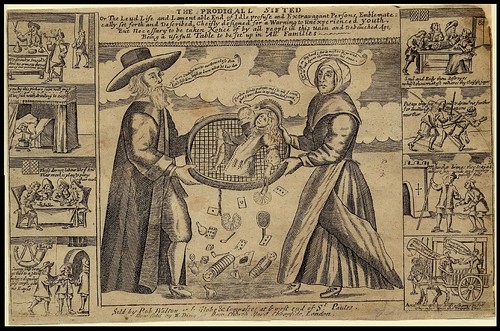
Title: The Prodigal Sifted, 1677
Description: Parents sieving their son surrounded by scenes of gambling, duelling, drinking, smoking, brothel, sickness and jail, in the margins.
Published by Robert Dalton and William Dicey
Inscription: Lettered with title, text within image, text above image and publication line: 'Sold by Rob. Walton at ye Globe & Compasses at ye west end of S.t Paules. Now Sold by W. Dicey in Bow-Church-Yard, Cheapside, London.'

Title: The discription of the Islandes and Castle of Mozambique.. 1598
Print made by William Rogers
After Johannes van Doetecum
Description: Map depicting Mozambique, with ships, a coat of arms, a sphere, and a compass; illustration to Jan Huygen van Linschoten, 'His Discours of Voyages into ye Easte and Weste Indies' (London, John Wolfe), between pp. 8 and 9.
Inscription: Lettered with title 'The discription of the Islandes and Castle of Mozambique [...]', after which: 'lyeinge vppon the borders of Melinde, rich of Eban wood, fine Goulde, and Ambergrize, fro[m] whence many Slaues are caried into India'. Several inscriptions identifying topographical features, and at top left: '8 & 9.' Lettered at bottom left: 'Printed at London by Iohn Wolfe / Grauen by William Rogers'.
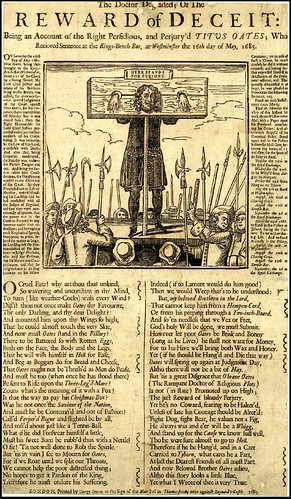
Title: The Doctor Degraded; or the Reward of Deceit, 1685
Published by George Groom
Description: Broadside on the punishment of Titus Oates; a depiction of Oates in the pillory, with text on either side and in two columns below.
Inscription: Lettered with title at top, and at foot of sheet, in letterpress: 'LONDON, Printed by George Groom, at the Sign of the Blue-Ball in Thames-street, over against Baynard's-Castle. 1685.' [see: Victorian Web / New Advent]
All of the above images were spliced together from screencaps. The majority (if not all) of the text on the prints ought to be legible if you click through on any image to the original version; however, the zoomify interface at the source site provides the highest resolution.
All the text above, despite some editing and rearrangement, is quoted from the source site. Where it says 'untitled', it just refers to the print itself, irrespective of whether the print is from a titled book or suite of engravings.
British Printed Images to 1700 is a significant database and a work in progress from a collaboration between the Victoria and Albert Museum, University College London and the British Museum. The site will present some challenges depending on your browser; some sections are not yet populated/indexed and I haven't yet done any searching. [previously: see The British Museum Print Database]
The above selection of images (probably a fair overview of the genres and subject matters available) were found from browsing through the 'producers' in the database. They were chosen from the first half of the alphabet. (I would guess that I saw perhaps 750 images at the very most so far; I presume, therefore, they have only uploaded 15% or thereabouts of the expected 10,000 prints. That said, I haven't had an intensive look around the site, which includes a wealth of interesting background material/essays and the like).
Using firefox, I cntrl-clicked to open 'larger images' in a new tab to see the background notes (otherwise it doesn't open). If you look at 'anonymous' in that producers section, for instance, you can quickly see a whole load of image thumbnails: just another way of getting a quick overview.
I knew of this site from the Print of the Month series: some images have been posted to BibliOdyssey in the past - (multi) - but I'm thankful to tellurian for posting about the parent site on Metafilter a day or two ago.
skip to main |
skip to sidebar


analytics
Books~~Illustrations~~Science~~History~~Visual Materia Obscura~~Eclectic Bookart.

Contact | Who?
Recommended Blogs
Blog Archives
Resource Sites
- digital nz
- library of congress
- british library
- library france
- library holland
- library spain
- library portugal
- european library
- library australia
- collections canada
- digital poland
- nypl digital
- botanicus digital
- v&a collections
- britmuseum prints
- smithsonian search
- smithsonian galaxy
- f.a.m.s.i.
- casglu'r tlysau
- rumsey collection
- manuscript catalogue
- digital scriptorium
- cesg manuscripts
- swiss manuscripts
- pecia mss blog
- digital book index
- rare book room
- online exhibitions
- primary sources
- worldcat search
- library directory
- digital librarian
- intute resources
- warburg institute
- lexilogos links
- digiwiki links
- museum blogs
- book arts web
- culture archive
- conservation articles
- art-history timeline
- visual arts
- arts journal
- artcyclopedia
- ukiyo-e
- calligraphy megapage
- penmanship
- woodblock
- coconino
- alchemy website
- health hist. img-banks
- health history links
- history network
- new advent


















7 comments :
The picture of the whale is tantalising! I would love to know more accurately when the event occurred.
wonderful pictures! that pineapple in the first picture looks a lot like a pinecone, though..
I did very briefly look around for cites about whale landings on the Thames, but it's not as rare as you would think. At least the response from the general populace has improved (there's a big wikipedia entry about a beaching in 2006; but rescue efforts failed).
Funny, those were the things I was going to comment on. I agree the alleged pineapple must be a pinecone.
These are brilliant -- well-chosen, and well-scanned. Remarkably enough, as I watched the pictures load, I was thinking about the engraving in Henderson's 'The Arraignment of the Whole Creature Att the Barre of Religion, Reason, Experience, etc." a copy of which, by pure chance, I inherited some years ago. And then there it was! On doing some research on this volume, I was sad to see that quite a few copies extant are lacking this engraving, presumably because someone has cut it out to sell, thinking it of greater value than the book.
Thanks also for the advice on using multiple images in Blogger -- it's been of much use.
(For anyone wondering, Russell is referring to an exchange we had on the Panorama Handbills post, in which a quote from him opened proceedings.)
Russell, I will take due credit for the image choice and splicing together of screen captures from the Flash interface, but I wasn't responsible for scanning the material.
I know books get taken apart but I think breaking up Books of Hours and medieval / illuminated manuscripts are the most notorious and objectionable assaults on the written heritage. Single manuscript pages appear on ebay every day.
thanks
i liked the whale a lot
Post a Comment
Comments are all moderated so don't waste your time spamming: they will never show up.
If you include ANY links that aren't pertinent to the blog post or discussion they will be deleted and a rash will break out in your underwear.
Also: please play the ball and not the person.
Note: only a member of this blog may post a comment.